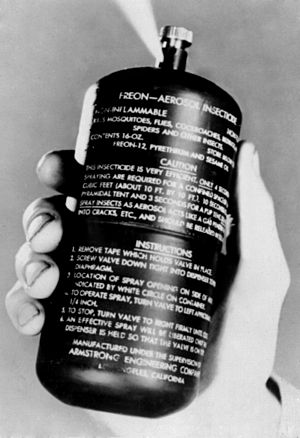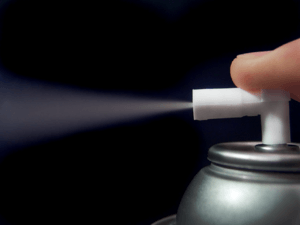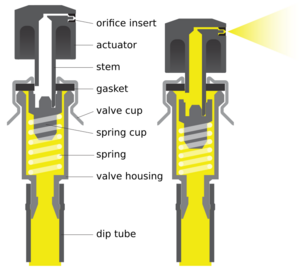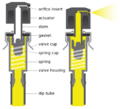Aerosol spray dispenser facts for kids
An aerosol spray is a special way to spray liquid particles into the air. Think of it like a fine mist! It comes in a can or bottle that holds the liquid product (like paint or hairspray) and a gas under pressure called a propellant. When you press the button, the product is pushed out of a tiny opening and turns into a mist or spray.
Contents
The History of Aerosol Sprays
The idea of aerosol sprays goes back a long time, possibly to 1790. But the first real patent for an aerosol spray can was given in Oslo, Norway, in 1927 to a chemical engineer named Erik Rotheim. The United States also granted a patent for his invention in 1931.

In 1939, an American named Julian S. Kahn got a patent for a disposable spray can. His idea was to mix cream and a gas to make whipped cream at home. However, his invention didn't really take off.
The "Bug Bomb" and World War II
The modern spray can we know today was truly developed in 1941 by Americans Lyle Goodhue and William Sullivan. They worked for the United States Bureau of Entomology and Plant Quarantine. Their invention was a refillable spray can, often called the aerosol bomb or bug bomb. This was the start of many spray products we use today.
Their "bug bomb" was a small steel can filled with a gas under pressure and a product that would spray out as a mist or foam. It was very useful during World War II in the Pacific. Soldiers used these small, portable cans to spray inside tents and airplanes. This helped protect them from malaria-carrying mosquitoes.
In 1948, the U.S. government allowed three companies to make aerosol sprays. Two of these companies, Chase Products Company and Claire Manufacturing, still make them today! In 1949, Robert H. Abplanalp developed the "crimp-on valve," which helped control the spray in low-pressure aerosol cans.
Protecting Our Planet: The Ozone Layer
In 1974, two scientists, Drs. Frank Sherwood Rowland and Mario J. Molina, suggested that certain chemicals used in aerosol sprays, called chlorofluorocarbons (CFCs), were harming Earth's ozone layer. The ozone layer is like a shield high in the atmosphere that protects us from the sun's harmful rays.
Because of this discovery, many countries worked together to protect the ozone layer. In 1985, the Vienna Convention was signed. Two years later, the Montreal Protocol was created. This agreement helped control and eventually stop the production of CFCs. By 1995, the U.S. had completely stopped using CFCs. This shows how science and teamwork can help solve big environmental problems!
How Aerosol Propellants Work
If aerosol cans just had regular compressed gas, they would either need to be under very high, dangerous pressure, or they wouldn't hold much product.
Instead, aerosol cans usually use a special gas that is actually a liquid inside the can. This liquid has a very low boiling point, meaning it turns into a gas easily, even at room temperature. This way, the gas inside the can is always at the right pressure to push out the product, but it's not dangerously high. As gas leaves the can, more liquid quickly turns into gas to replace it.
Types of Propellants
As you learned, Chlorofluorocarbons (CFCs) were once common propellants. But since the Montreal Protocol in 1989, they have been replaced in most countries because they harm the ozone layer.
Today, common replacements are mixtures of gases like propane, n-butane, and isobutane. These are all flammable, meaning they can catch fire. Other propellants include dimethyl ether (DME) and methyl ethyl ether.
For food products like whipped cream or cooking spray, gases like nitrous oxide and carbon dioxide are used. For medical sprays, such as asthma inhalers, special gases called hydrofluoroalkanes (HFAs) are used.
How Aerosol Cans are Packaged
Modern aerosol spray products have three main parts:
- The can: This is usually made of lacquered tinplate (steel with a layer of tin) or Aluminium cans. Aluminum cans are often used for more expensive products.
- The valve: This part is crimped to the inside rim of the can. Its design is important because it controls how fast the spray comes out.
- The actuator or button: This is the part you press to open the valve. When you let go, a spring closes the valve. The shape and size of the nozzle on the actuator control how fine the spray is and how wide it spreads.
Other Ways to Spray Products
Not all spray products use a propellant that mixes with the product. Some alternatives include:
- Spray bottles and squeeze bottles: These are simple pumps or squeeze mechanisms that don't use a propellant gas.
- Piston barrier systems: These are used for thick products like hair gels or creams. A piston inside the can pushes the product out, keeping it separate from the gas. This means the product stays pure and is used up almost completely.
- Bag-in-can (or BOV, bag-on-valve) systems: In this system, the product is held in a sealed bag inside the can. The gas is outside the bag, pushing on it to spray the product out. This keeps the product pure and allows it to be sprayed from any angle.
There are also 2K (two component) aerosol sprays. These cans have two different parts stored separately. When you activate the can, the two parts mix together. This is useful for products that need to react and harden, like some paints, foams, or adhesives.
Safety Tips for Aerosol Sprays
Aerosol cans can have some safety concerns:
- Cold Burns: Spraying an aerosol directly onto skin can cause a cold burn, sometimes called "frosting." This happens because the gas inside cools down very quickly when it leaves the can.
- Flammability: Many aerosol propellants are gases that can catch fire or even explode. Always use them in a well-ventilated area and away from flames. However, some aerosols use non-flammable gases like nitrogen or nitrous oxide, especially for things like air fresheners or whipped cream.
- Chemicals: Sometimes, unwanted chemicals like benzene can be found in small amounts in some hydrocarbon propellants. Companies test their products carefully to make sure they are safe.
In the United States, aerosol cans that are not empty are considered hazardous waste. However, empty cans can often be recycled in regular recycling programs.
See Also
 In Spanish: Pulverizador para niños
In Spanish: Pulverizador para niños
- Aerosol paint
- Fabrican
- Graffiti
- Silly String
- Spray nozzle
Images for kids







